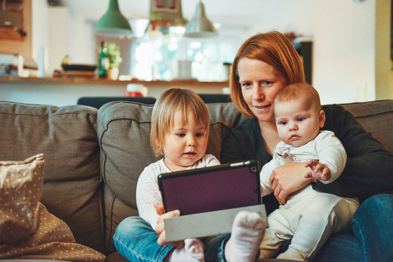
What is AAC?
AAC is an abbreviation for Augmentative and Alternative Communication. It is a way to enhance communication for people who have significant speech and language impairments (Light et al, 1999). It includes all forms of communication such as writing or gestures that can be used to express thoughts (ASHA). It DOES NOT INHIBIT speech production skills! In fact, research has shown that AAC has positive benefits on speech production (Romski & Sevcik, 1996). AAC can actually decrease behaviors and increase language because it reduces the pressure to speak verbally and reduces motor and cognitive demands of communicating (Lloyd & Kangas, 1994). In adults, using AAC is a way to regain communication after skills are lost due to diseases such as ALS, Parkinson's, or if the patient had a stroke or brain injury. In children who are non-verbal, the goal of using AAC is for the student to develop communicative competence. Binger, Agate, & Ramsay, 1999)
What Is Communicative Competence?
Communicative Competence is when a child effectively communicating his/her message to the listener for one or more of the purposes of communication, which is to express our wants and needs, build relationships, share information, and use social etiquette (Light, 1988).
Eligibility varies and each individual needs to be assessed for eligibility by a Speech Pathologist. Communicative ability as well as trials with a variety of devices will be performed prior to choosing the communication method that is most appropriate for that individual. Insurance will often pay for the devices and Speech Pathologists will need to provide training on the devices. You can contact Cove Speech Therapy today to request an AAC evaluation and determine what kind of communication device would be best!
(516) 669-0434
AAC is an abbreviation for Augmentative and Alternative Communication. It is a way to enhance communication for people who have significant speech and language impairments (Light et al, 1999). It includes all forms of communication such as writing or gestures that can be used to express thoughts (ASHA). It DOES NOT INHIBIT speech production skills! In fact, research has shown that AAC has positive benefits on speech production (Romski & Sevcik, 1996). AAC can actually decrease behaviors and increase language because it reduces the pressure to speak verbally and reduces motor and cognitive demands of communicating (Lloyd & Kangas, 1994). In adults, using AAC is a way to regain communication after skills are lost due to diseases such as ALS, Parkinson's, or if the patient had a stroke or brain injury. In children who are non-verbal, the goal of using AAC is for the student to develop communicative competence. Binger, Agate, & Ramsay, 1999)
What Is Communicative Competence?
Communicative Competence is when a child effectively communicating his/her message to the listener for one or more of the purposes of communication, which is to express our wants and needs, build relationships, share information, and use social etiquette (Light, 1988).
- Children must be taught how to use their AAC system to be effective communicators
- It is a step-by-step process that takes hard work, commitment by caregivers, and instruction! The SLP, with assistance from the caregiver, will identify meaningful and appropriate opportunities for communication. For communication to become effective, the child must use AAC wherever communication is taking place! It cannot be practiced in the speech room alone.
- What is the Difference Between High & Low Tech Devices?
- A high tech device involves technology such as a speech generating device. It can be fragile as it usually has screen and requires maintenance like daily charging. Users press buttons and the device will speak. High tech devices have the capability to become dynamic, meaning as the person's needs change, the device can change as well. Picture sizes can be altered, buttons can be added, etc. For patients who lack mobility, high tech devices can be controlled by switches or by eye gaze. A low tech device may involve gestures, paper and pen, or pointing to symbols and letters on a communication board. These a usually more static in nature, meaning changing pictures may require printing and laminating a new board every time a change is needed. Both options can be very portable!
Eligibility varies and each individual needs to be assessed for eligibility by a Speech Pathologist. Communicative ability as well as trials with a variety of devices will be performed prior to choosing the communication method that is most appropriate for that individual. Insurance will often pay for the devices and Speech Pathologists will need to provide training on the devices. You can contact Cove Speech Therapy today to request an AAC evaluation and determine what kind of communication device would be best!
(516) 669-0434
References
Light, J. (1988). Interaction involving individuals using augmentative and alternative communication: State of the art and future research directions. Augmentative and Alternative Communication, 4, 66–82
Light, J. (1997). “Communication is the essence of human life”: Reflections on communicative competence. Augmentative and Alternative Communication, 13(2), 61-70.
Light, J. C., Binger, C., Agate, T. L., & Ramsay, K. N. (1999). Teaching partner-focused questions to individuals who use augmentative and alternative communication to enhance their communicative competence. Journal of Speech, Language, and Hearing Research, 42(1), 241-255.
Lloyd, L. L. & Kangas, K. (1944). Augmentative and alternative communication. In G.H. Shames, E. H., Wiig, & W.A. Secord (Eds.), Human communication disorders (4th ed., pp 606-657). New York: Merrill/Macmillan.
Romski, M. A., & Sevcik, R. A. (1996). Breaking the speech barrier: Language development through augmented means. Brookes Publishing Company, Maple Press Distribution Center, I-83 Industrial Park, PO Box 15100, York, PA 17405.
Light, J. (1988). Interaction involving individuals using augmentative and alternative communication: State of the art and future research directions. Augmentative and Alternative Communication, 4, 66–82
Light, J. (1997). “Communication is the essence of human life”: Reflections on communicative competence. Augmentative and Alternative Communication, 13(2), 61-70.
Light, J. C., Binger, C., Agate, T. L., & Ramsay, K. N. (1999). Teaching partner-focused questions to individuals who use augmentative and alternative communication to enhance their communicative competence. Journal of Speech, Language, and Hearing Research, 42(1), 241-255.
Lloyd, L. L. & Kangas, K. (1944). Augmentative and alternative communication. In G.H. Shames, E. H., Wiig, & W.A. Secord (Eds.), Human communication disorders (4th ed., pp 606-657). New York: Merrill/Macmillan.
Romski, M. A., & Sevcik, R. A. (1996). Breaking the speech barrier: Language development through augmented means. Brookes Publishing Company, Maple Press Distribution Center, I-83 Industrial Park, PO Box 15100, York, PA 17405.
